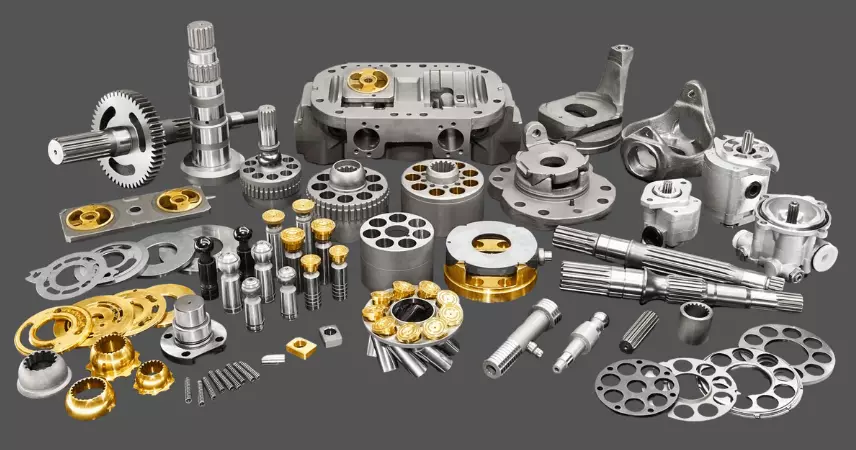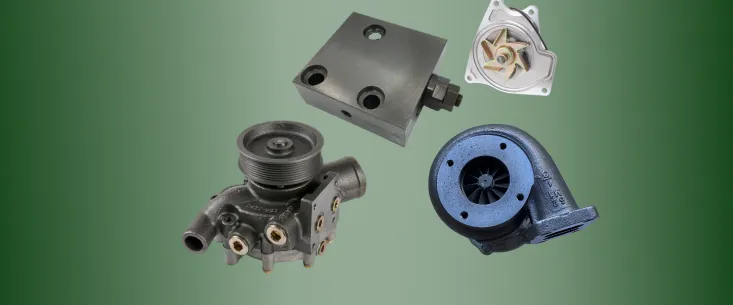+86-135 3388 0668
The Mechanics and Functionality of Manual Hydraulic pumps

When it comes to powering heavy machinery and ensuring efficient performance in demanding environments, few tools are as reliable as manual hydraulic pumps. These hydraulic pumps are a staple in industries where lifting, pushing, or compressing materials is part of the everyday routine. While hydraulic technology is well-known for its ability to deliver immense power through fluid systems, manual hydraulic pumps bring unique advantages when it comes to providing portability, control, and efficiency without the need for complex electrical systems.
Understanding the Basics of hydraulic systems
To fully appreciate the importance of manual hydraulic pumps, it’s crucial to understand the basic principles of hydraulic systems. A hydraulic system uses pressurized fluid to transfer power from one location to another, allowing for the application of force in areas where traditional mechanical systems may fall short. This system is made up of several components, including pumps, cylinders, valves, and reservoirs. When pressurized fluid flows through these components, it creates mechanical energy that is harnessed for various tasks.

A manual hydraulic pump is essentially the heart of this system. It uses human-operated pressure to generate hydraulic force. This pressure is applied to a piston inside the pump, which pushes hydraulic fluid through the system, providing force to the connected tools or machinery. Unlike powered hydraulic pumps that rely on electric or engine-driven motors, manual hydraulic pumps offer the advantage of being fully independent of external power sources, making them a preferred choice for applications where portability and simplicity are essential.
The Components of a Manual Hydraulic Pump
A typical manual hydraulic pump consists of several key components that work in unison to generate hydraulic force:
Pump Body: The main housing of the pump, which contains all the other components.
Pump Lever or Handle: The lever is the manual component of the pump. It is used by the operator to create mechanical force, which is converted into hydraulic pressure.
Piston or Cylinder: This is the part of the pump that moves back and forth to generate pressure when the lever is operated. The piston is responsible for forcing fluid through the hydraulic system.
Reservoir: The fluid reservoir holds the hydraulic fluid, ensuring that the system has a continuous supply of fluid for operation.
Control Valve: This valve controls the flow of hydraulic fluid, ensuring that it reaches the intended part of the system, such as a hydraulic jack or lift.
The combination of these components allows manual hydraulic pumps to perform a wide range of tasks with impressive efficiency. Their simple design, ease of use, and minimal maintenance requirements make them an attractive option for various industries.
Benefits of Manual Hydraulic Pumps
Manual hydraulic pumps bring several distinct advantages over their motorized counterparts, particularly in situations where portability, control, and low maintenance are essential. Let’s explore some of the key benefits:
1. Portability: One of the main advantages of manual hydraulic pumps is their portability. These pumps are typically compact and lightweight, making them ideal for use in locations where space is limited, or where external power sources are unavailable. From construction sites to automotive workshops, manual hydraulic pumps can be easily transported to the job site and used on the go.
2. Simple Operation: Manual hydraulic pumps are user-friendly, requiring minimal training to operate. By simply engaging the pump lever or handle, the operator can quickly build hydraulic pressure to perform a wide range of tasks. This simplicity also reduces the likelihood of user error, making them an accessible option for both professional operators and novices alike.
3. Durability: These pumps are designed to be tough and resilient, capable of withstanding harsh working conditions. Built with high-quality materials, manual hydraulic pumps are resistant to wear and tear, ensuring long-lasting performance. This durability is particularly important in industries such as construction and automotive, where the equipment is often exposed to challenging environments.
4. No Need for External Power: One of the standout features of manual hydraulic pumps is their independence from external power sources. Unlike electric or fuel-powered pumps, manual hydraulic pumps do not require a battery or a connection to an electrical grid. This makes them especially useful in remote locations or situations where access to power may be limited.
5. Energy Efficiency: Since manual hydraulic pumps are powered entirely by human effort, they do not rely on the consumption of electricity or fuel. This makes them more environmentally friendly compared to powered pumps, and they can be used without worrying about the environmental impact of energy consumption.
Applications of Manual Hydraulic Pumps
Manual hydraulic pumps are used across a wide range of industries, from automotive repair to industrial manufacturing. Let’s take a look at some of the common applications where these pumps prove invaluable:
1. Automotive and Mechanical Repair: Manual hydraulic pumps are a key component in automotive repair, particularly in the form of hydraulic jacks and lifts. These pumps are used to lift heavy vehicles, allowing mechanics to work on the undercarriage with ease. They are also employed in tire changes, transmission repairs, and other tasks that require lifting and pushing heavy components.
2. Construction and Engineering: In construction, manual hydraulic pumps are used for tasks such as lifting heavy loads, adjusting structural elements, and applying force to materials. These pumps are commonly used in situations where large machines cannot reach, offering a portable and efficient solution for various lifting and compression needs.
3. Manufacturing and Production: In manufacturing, manual hydraulic pumps are used to operate presses, molds, and other machinery that requires high levels of force. These pumps are vital in industries such as metalworking, plastics, and woodworking, where precise pressure is required for shaping and forming materials.
4. Agricultural Equipment: Manual hydraulic pumps are also used in agricultural equipment, such as tractors and harvesters. These pumps help to lift heavy loads, control implements, and operate hydraulic cylinders that are critical for the functionality of modern farming machinery.
In all these applications, manual hydraulic pumps provide the necessary hydraulic power to get the job done efficiently and effectively, offering a simple and reliable solution to complex tasks.
The Future of Manual Hydraulic Pumps and Emerging Trends
While manual hydraulic pumps have proven their value in a range of industries, the future of these tools looks even more promising, thanks to ongoing technological advancements. As industries continue to evolve, so too do the tools that power them. In this part of the article, we’ll explore how the future of manual hydraulic pumps is shaping up, as well as emerging trends in hydraulic technology that are poised to enhance the functionality and performance of these essential tools.
Technological Advancements in Manual Hydraulic Pumps
Recent developments in hydraulic pump technology have focused on improving efficiency, safety, and ease of use. Here are some of the trends that are shaping the future of manual hydraulic pumps:
1. Improved Materials and Construction: One of the major areas of advancement in manual hydraulic pumps is the use of advanced materials. New alloys, composites, and high-strength plastics are being incorporated into the design of hydraulic pumps, making them lighter, more durable, and resistant to corrosion. These improvements will enhance the lifespan and performance of manual hydraulic pumps, particularly in harsh environments.
2. Enhanced Precision and Control: As industries demand higher levels of precision in their operations, manufacturers are developing hydraulic pumps with more refined control mechanisms. New valve designs and more responsive pistons allow for finer adjustments to hydraulic pressure, enabling users to perform delicate operations with greater accuracy. This will be particularly beneficial in fields such as manufacturing, where precision is paramount.
3. Integration with Digital Systems: Another emerging trend is the integration of manual hydraulic pumps with digital monitoring systems. While manual hydraulic pumps are traditionally operated by human effort, there is growing interest in adding sensors and feedback mechanisms to track pressure levels, fluid levels, and pump performance. This data can be transmitted to digital devices, providing users with real-time insights into the status of the pump and system.
4. Compact and Ergonomic Designs: As the demand for more portable tools increases, manual hydraulic pumps are being designed to be even more compact and ergonomic. With a focus on ease of use, manufacturers are creating pumps that require less physical effort to operate, reducing strain on the user while maintaining the same level of hydraulic power.
Challenges and Opportunities
Despite their many advantages, manual hydraulic pumps are not without their challenges. One of the main issues is the physical effort required to operate them. While they are relatively easy to use, the manual effort needed for larger pumps can be a limiting factor in certain applications. Manufacturers are working to address this challenge by creating more efficient designs that require less force to generate the necessary hydraulic pressure.
Another challenge is the need for proper maintenance. While manual hydraulic pumps are generally low-maintenance, they still require regular checks to ensure that the hydraulic fluid is at the proper level and that the pump components are functioning correctly. Ongoing advancements in fluid technology and pump design are helping to minimize maintenance needs, but users should remain vigilant to ensure the longevity and reliability of their pumps.
Despite these challenges, the future of manual hydraulic pumps is bright. As technology continues to evolve, these pumps are likely to become even more powerful, efficient, and user-friendly, making them an indispensable tool in a variety of industries.
Manual hydraulic pumps are a critical part of many industrial operations, offering a powerful and efficient solution for lifting, pushing, and compressing materials. With their portability, simplicity, and durability, these pumps continue to be a go-to tool for professionals across industries. As technology advances, manual hydraulic pumps are set to become even more effective and versatile, ensuring that they remain an essential tool for years to come.
From automotive repair to construction and agriculture, manual hydraulic pumps have earned their place as indispensable tools that keep the wheels of industry turning. As the world continues to evolve, so too will the tools that help us power the future, and manual hydraulic pumps will undoubtedly remain at the forefront of this technological revolution.
Search
Blog & News